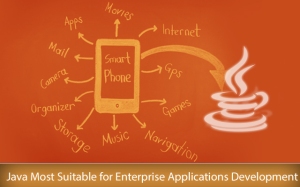 A developer needs to understand several widely used technologies to build large-scale and robust enterprise applications. But many programmers prefer Java programming environment to build comprehensive business solutions by availing a number of advantages. As Java is platform independent, it allows developers to develop global enterprise solutions and web services to target major operating systems and computing devices. At the same time, some of the original limitations of the technology can be overcome by using inexpensive mass storage devices and faster processors
A developer needs to understand several widely used technologies to build large-scale and robust enterprise applications. But many programmers prefer Java programming environment to build comprehensive business solutions by availing a number of advantages. As Java is platform independent, it allows developers to develop global enterprise solutions and web services to target major operating systems and computing devices. At the same time, some of the original limitations of the technology can be overcome by using inexpensive mass storage devices and faster processors
The performance of an enterprise application depends on a number of factors. Along with use of multiple threads and object serialization, the system also needs be deployed in a proper way. A programmer can meet all these requirements by using Java to develop business applications. The Java Run-time Environment (JRE) is designed as a specialized version of Java classes and interpreter to make the application deployment process hassle-free. The JRE does not include any tool required to develop applications. But it includes the classes required to deploy the enterprise applications.
Most developers also use Java plug-in to boost the performance of their interfaces without putting any extra effort. As a web browser extension, the plug-in works seamlessly with major web browsers. Further, the end users can simply install the plug-in to run a variety of Java applets to meet their individual requirements. A programmer can use the plug-in to release customized applets that can be used by the end-users without updating or changing their web browsers.
The required amount of security and reliability often make enterprise application development complex. Most organizations also opt for multi-tiered applications to segregate their functionalities into tiers or isolated functional areas. The Java EE platform has made enterprise application development less complex by offering an API, development model and runtime environment. The runtime environment also makes it easier for programmers to concentrate on the functionality and performance of their enterprise systems.
Using Java for Multi-Tier Enterprise Application Development
Client Tier: The client tier of the application consists of clients that are located on machines different from the server. The clients access the Java EE server, and send requests to the server for processing. The server processes the requests, and returns back responses to client. Based on the requirements of your project, you can use a variety of applications as Java EE clients. Some of these applications can also be developed using other programming languages. At the same time, the clients can be a standalone interface, a web browser or any other server. But the clients must run on a machine that is different from the Java EE server.
Web Tier: The web tier of a business system includes components that handle the interaction between business tier and clients. Along with generating dynamic content for the client, and controlling the flow of pages or screen, the web tier further maintains data for the session state of the client. Also, the tier is used to collect input from users, and return appropriate content or results from the business tier components. A programmer has options to use variety of Java EE technologies to build the web tier of a business system, including JavaServer Pages (JSP), JavaServer Pages Standard Tag Library, JavaServer Faces technology, JavaServer Faces Facelets technology, Servlets, JavaBeans Components and Expression Language.
Business Tier: The business logic for an enterprise solution is supported by the components included in the business tier. Normally, the business logic can be defined as the code that adds functionality to a specific business domain. While developing enterprise applications, the programmers ensure that the core functionalities exist in the business tier components. A developer also has option to use a variety of Java EE technologies in the business tier of the application including Enterprise JavaBeans, JAX-WS web service endpoints, Java Persistence API entities, JAX-RS RESTful web services, and Java EE managed beans.
Enterprise Information Tier: The enterprise information tier of a business system consists of enterprise resource planning (ERP) systems, database servers, and legacy data sources like mainframes. Normally, these resources are located on a machine different from the Java EE server. The components of enterprise information tier are frequently accessed by the business tier components. A programmer can use several Java EE technologies to store, modify, access and manage the business data in a simpler and hassle-free way.
Many reports have highlighted the advantages of Java over other programming language for custom-developed enterprise application development projects. The upcoming release of Java 8 will further help developers to enhance the performance of their applications by availing a set of advanced and fresh features. Certified java programmers can help you build projects within allocated budgets and time schedules.
If you want to hire a java developer for your java application development needs, please contact us at Mindfire Solutions.